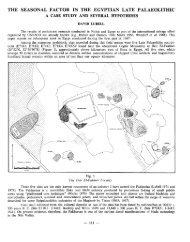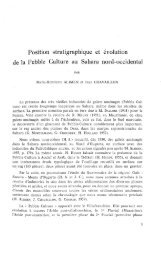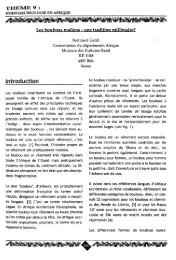Tichitt-Walata and the Middle Niger - PanAfrican Association of ...
Tichitt-Walata and the Middle Niger - PanAfrican Association of ...
Tichitt-Walata and the Middle Niger - PanAfrican Association of ...
Create successful ePaper yourself
Turn your PDF publications into a flip-book with our unique Google optimized e-Paper software.
438 Kevin C. MacDonald<br />
That <strong>the</strong>re was movement between <strong>the</strong> Merna <strong>and</strong> <strong>Tichitt</strong>-<strong>Walata</strong> is evidenced by imported<br />
stone materials <strong>of</strong> Phthanite, Amazonite <strong>and</strong> Jasper from Mauritania. Indeed, it is possible that<br />
Ndondi Tossokel <strong>and</strong> Kobadi trade contact long predates <strong>the</strong> first arrival <strong>of</strong> <strong>the</strong> former's settlements<br />
in <strong>the</strong> region. Above all, trade could have been in <strong>the</strong> form <strong>of</strong> commodities: rare stones <strong>and</strong> cattle for<br />
fish <strong>and</strong> possibly grain.<br />
Around 1300 BC it would also appear that <strong>the</strong> Kobadi tradition underwent a shift, with <strong>the</strong><br />
appearance <strong>of</strong> Ben5touma ware. This may simply represent a later phase <strong>of</strong> <strong>the</strong> Kobadi tradition, but<br />
it is notable that Beretouma ceramics occur frequently on sites where Kobadi <strong>and</strong> Ndondi-Tossokel<br />
ceramics co-exist. Is it possible that <strong>the</strong> Beretouma tradition might instead be a product <strong>of</strong> contact<br />
between <strong>the</strong>se two groups? In some cases <strong>the</strong> two populations appear to have lived side by side, or<br />
at <strong>the</strong> very least <strong>the</strong>re was a seasonal trade between <strong>the</strong>m.<br />
Evidence to support this assertion comes from <strong>the</strong> pastoral element <strong>of</strong> <strong>the</strong> Ndondi Tossokel<br />
economy. If <strong>the</strong> cattle had not yet developed tsetse resistance, a substantial seasonal displacement to<br />
<strong>the</strong> north would have been essential for <strong>the</strong>ir herds survival, <strong>and</strong> would have constituted a barrier to<br />
any southward penetration <strong>of</strong> <strong>the</strong> zone (Smith 1979). Even if <strong>the</strong>ir livestock were tsetse resistant, it<br />
would have been difficult for <strong>the</strong>m to have survived in a floodplain environment during <strong>the</strong> wet<br />
season if only for reasons <strong>of</strong> space <strong>and</strong> ho<strong>of</strong>-rot. In any event, <strong>the</strong>ir displacements need not have<br />
been <strong>the</strong> vast migrations practised by modern pastoral groups. Wet season settlements could even<br />
have been located less than 50 km away, at <strong>the</strong> Mauritanian s<strong>and</strong>stone inselbergs <strong>of</strong> which Saberi<br />
Faita is <strong>the</strong> sou<strong>the</strong>rnmost. Questions <strong>of</strong> this nature will remain unanswerable until work is continued<br />
in <strong>the</strong> Merna, <strong>and</strong> survey is conducted in <strong>the</strong> adj9ining Dhar Nema region.<br />
Acknowledgements<br />
I would like to thank Tereba Togola for our long-st<strong>and</strong>ing friendship <strong>and</strong> continuing collaboration.<br />
I am also grateful to Patrick Munson for access to collections <strong>and</strong> some enlightening discussions.<br />
Funding for my participation in <strong>the</strong> Merna Project was supplied by a Thomas J. Watson Fellowship<br />
(1989/90).<br />
References<br />
Adamson, D., Clark, J.D. <strong>and</strong> Williams, M.AJ. 1987. Pottery tempered with sponge from <strong>the</strong><br />
White Nile, Sudan. African Archaeological Review 5: 115-27.<br />
Amblard, S. 1984. <strong>Tichitt</strong>-<strong>Walata</strong> (R.I. Mauritanie): civilisation et industrie lithique. Paris:<br />
Editions Recherches sur les Civilisations, Memoire no. 35.<br />
Amblard, S. <strong>and</strong> Pernes, J. 1989. The identification <strong>of</strong> cultivated pearl millet (Pennisetum)<br />
amongst plant impressions on pottery from Oued Chebbi (Dhar Oualata, Mauritania). African<br />
Archaeological Review 7: 117-26.<br />
Bedaux, R.M.A. <strong>and</strong> Lange, A.G. 1983. Tellem reconnaissance archeologique d' une culture de<br />
l'Ouest Africain au Moyen Age: la poterie. Journal des Africanistes 53: 5-59.<br />
Brissaud, 1. <strong>and</strong> Houdayer, A. 1986. Sponge spicules as characteristic <strong>of</strong> ancient African pottery<br />
from Mali. Journal <strong>of</strong> Field Archaeology 13: 357-8.<br />
Dieterlen, G. <strong>and</strong> Sylla, D. 1992. L'Empire de Ghana: Ie Wagadou et les traditions de yerere.<br />
Paris: Editions Karthala.<br />
Furon, R. 1929. L'ancien delta du <strong>Niger</strong> (Contribution a l'etude de l'hydrographie ancienne du<br />
Sahel Soudanais). Revue de Geographie Physique et Geologie Dynamique 2: 265-74.<br />
Georgeon, E., Dutour, O. <strong>and</strong> Raimbault, M. 1992. Paleoanthropologie du gisement lacustre<br />
neolithique de Kobadi (Mali). Prehistoire et Anthropologie Mediterraneennes 1: 85-97.





